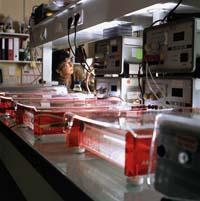Paleontologist, care in the collection of fossils

DNA is a very delicate material, especially if it is ancient. The DNA found in the fossils is scarce, since over the years it is deteriorating. Therefore, it is recommended to freeze immediately after receiving the fossil without removing the land that has adhered. In addition, other measures should be taken (gloves, etc.) to avoid contamination of the fossil's genetic material with the outside.
To carry out these recommendations, paleontologists from the Jacques Monod Institute in Paris have compared the results between the traditional collection of fossils and that carried out in a more sterile environment. For this purpose, fossils collected in two different periods have been used. The fossils correspond to a sore that lived 3,200 years ago, of the same grain: one of them was collected in 1947 and visited in the museum, and the other, taking measures for the conservation of the genetic material that were collected in 2004, conserving it at -20ºC.
Well, the fossil that has been in the museum could not extract genetic material. Of all the other fossils. Therefore, the difference between both methods is evident. And although the intuition itself also mandated it, there is now clear evidence to say that fossils should be collected as sterile as possible.





